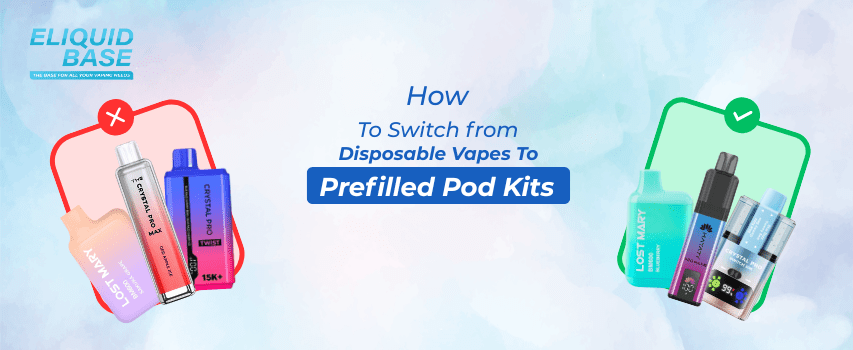
Are Vape Juices Safe? Understanding the Ingredients
Over the years, the world has seen a drastic change in different aspects of life. With the evolution of technology, vaping has surged as an alternative to traditional cigarette smoking.
What is Vape Juice?
Vape juice or e-juice is a liquid specifically designed for personal vaporizers and electronic cigarettes. The coil heats up, turning the e-juice into vapours that you inhale. Vape juices are readily available in a diverse range of flavours with varying nicotine strengths.
Know the Ingredients
Vape juices are composed of various ingredients, which may vary, but the primary ingredients remain the same, which are as follows.
Propylene Glycol (PG)
It is a synthetic organic compound used in the manufacturing of food, pharmaceuticals, and cosmetics. It is odorless and colourless with a sweet hint. In vape juices, PG is used to deliver flavour and ensure a smooth throat hit that mimics the likes of smoking. PG is labelled ‘generally safe’ for ingestion by the FDA. Research has shown that PG is low risk when consumed in smaller amounts for the short term.
Vegetable Glycerin (VG)
VG is a thicker liquid that is extracted from vegetable oils, as the name suggests. It is commonly found in skincare and food products, or even some medicines. In the world of vaping, VG plays an integral role in the production of dense cloud vapors. It is smoother than PG inhalation. It is recognized as safe by the FDA, but not much research has been done on it. Overconsumption may lead to phlegm buildup or dehydration.
Flavourings
Vape juices consist of artificial flavours that mimic the likes of fruits, menthol, or tobacco. Mostly, they are made of artificial and natural compounds that are food-grade. Despite its widespread use, it is not considered safe for inhalation. Compounds like diacetyl found in these flavours have been linked to disorders like Bronchiolitis Obliterans, or simply popcorn lung. Renowned manufacturers are now avoiding the use of harmful substances like diacetyl and acetyl propionyl. Nevertheless, this industry remains unregulated
Nicotine
Nicotine is naturally found in tobacco-based plants, which is an addictive substance. This stimulant is consumed by people to feel ecstatic, alert, focused, or relaxed. Owing to its dependence-inducing qualities, nicotine causes health issues like cardiovascular diseases, neurological effects, nausea, and increased heart rate.
Other Substances
Besides the above-mentioned primary products, some vape juices may contain hidden substances like formaldehyde, which is produced from overheating of e-liquid. Trace elements like nickel, kanthal, tin, and lead may leach from vape coils, which are heavy metals. Some vape juices may include low levels of Volatile Organic Compounds.
Is Vaping Safer than Smoking?
Vaping is 95% less harmful than smoking, states Public Health England. The absence of combustion is the main reason for this figure. Because it lessens the exposure to substances like tar, carbon monoxide, and other trace elements found in cigarette smoke. Nevertheless, remember that being less harmful does not mean it is harmless, since long-term effects are still under research.
What Affects the Safety of Vape Juice?
The safety of vape juice can be affected by several factors, like the quality of flavours, manufacturing standards, storage, and device conditions. Where high-quality and food-grade VG, PG flavourings lessen health risks. Ensure that the manufacture of your desired vape juice follows strict regulation measures like third-party testing or GMP certification to ensure hygiene.
Moreover, exposure to air, heat, and light degrades the ingredients found in vape juice, turning it bad. Hence, store them in cool, dry, and dark places like cupboards or drawers. To prevent excessive degradation of your vape juice, ensure that you are using your device on the correct wattage and temperature.
Tips for Safer Vaping
-
Choose some good reputable brands that have undergone transparency standards
-
Check ingredients for any diacetyl-containing flavours
-
Make use of the right temperature and wattage settings
-
Clean and maintain your device regularly
-
Store your vape juices in optimal conditions
-
Keep a check on your health, like any breathing or chest issues.
Since the evolution of the vaping industry, its regulation is catching up. Well-known authorities like the FDA and MHRA (UK) are working to ensure that vape products meet higher safety standards. Further research is being done to study long-term health outcomes and refine safe manufacturing standards. Consumers must stay informed and proactive as the dynamics evolve.
Final Thoughts
Vape juices are generally considered safer than smoking tobacco. However, they do not come without risks like any other consumable product. There are certain concerns relating to the inhalation of certain flavoring chemicals, the presence of nicotine, and the potential for device-related toxins. Hence, understanding ingredients, choosing high-quality products, and staying updated on emerging research may help big time.



